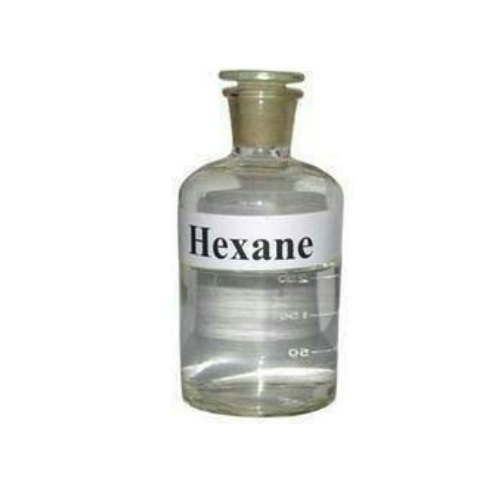
HEXANE
Appearance Colourless volatile liquid
Odour Gasoline-like odour
Vapour Pressure 17.60 kPa (at 20.0 °C)
Complexity 12
Viscosity 3.26 10-4 Pa-s at 20℃
Solubility 9.5 mg L-1
Hexane is an organic compound, a straight-chain alkane with six carbon atoms with the molecular formula C6H14. It is an odorless and colorless liquid, when pure, and it has a boiling point of approximately 69 °C (156 °F). It can be used widely as a relatively safe, largely unreactive, cheap, and easily evaporated non-polar solvent.
Hexane is a significant gasoline constituent. At times, it refers to a mixture, which is composed largely (> 60%) of hexane, with differential amounts of the isomeric compounds: 2-methyl pentane, 3-methyl pentane, and, possibly, the smaller amounts of non-isomeric C5, C6, C7 alkanes (cyclo). Hexane is one of the cheaper compounds and is often used in large-scale operations without requiring a single isomer (a cleaning solvent or for chromatography, as an example).
The other names of hexane can be given as 1-Hexanol, Amyl Carbinol, 1-Hydroxyhexane, and Hexyl alcohol.
Properties of Hexane
The physical properties of Hexane - C6H14 are as follows.
The chemical properties of Hexane - C6H14 are as follows.
Chemical Properties of Hexane - C6H14
|
IUPAC Name |
Hexane |
|---|---|
|
Molecular Weight or Molar Mass |
86.18 g/mol |
|
Density |
655 kg/m3 |
|
Boiling Point |
68.5 to 69.1 °C |
|
Melting Point |
−96 to −94 °C |
|
Chemical Formula |
CH3(CH2)4CH3 |
Hexane compound undergoes a combustion reaction readily to produce water and carbon dioxide molecules. The chemical reaction is given below.
2C6H14 + 19O2 → 12CO2 + 14H2O
Hexane, being the higher hydrocarbon, undergoes thermal cracking produces more than one hydrocarbon.
C6H14 (by thermal cracking) → C4H10 (called butane) + C2H4 (called ethene)
Hexane Structure - C6H14
The structure of Hexane can be represented as follows.
(Image Will be Updated Soon)
Production of Hexane
Hexanes are obtained chiefly by crude oil refining. This fraction's exact composition largely depends on the oil source (reformed or crude) and the refining constraints. The industrial product (in general, around 50% by straight-chain isomer weight) is given as the fraction boiling at 65-70 °C (149-158 °F).
Uses of Hexane
Industrially, hexanes can be used in the formulation of glues for shoes, roofing, and leather products. They can also be used to extract cooking oils (like soy oil or canola oil) from seeds, for degreasing and cleaning a variety of items, and in the manufacturing of textiles. Commonly, in the United States, they are used in food-based soybean oil extraction, and also they are potentially present as contaminants in all those soy food products where the technique can be used; the lack of regulation by the FDA (Food and Drug Administration, the USA) of this contaminant is some controversy matter.
One of the typical laboratory hexanes used is to extract grease and oil contaminants from water and soil for analysis. Since the hexane solvent or hexane compound cannot be easily deprotonated, it can be used in the laboratory for reactions, involving the stronger bases, like the organolithiums preparation. As an example, typically, butyllithiums are supplied as a hexane solution.
In general, hexanes are used as a non-polar solvent in chromatography. Higher alkanes exist as impurities in hexanes that contain the same retention times as that of solvent, which means that the fractions containing hexane also contain these impurities. In the case of preparative chromatography, the large volume of hexane concentration can result in a sample, which is appreciably contaminated by alkanes. This can result in a solid compound being obtained as an oil, and the alkanes may interfere with the analysis.
Hexane Safety
Hexane's acute toxicity is rather low. Inhaling n-hexane or hexane n at 5000 ppm for just 10 minutes produces marked vertigo. If it is 2500-1000 ppm for 12 hours, it can produce fatigue, appetite loss, drowsiness, paresthesia in the distal extremities. If 2500–5000 ppm, it can produce cold pulsation in the extremities, muscle weakness, headache, anorexia, and blurred vision.
Chronic occupational exposure to the elevated levels of n-hexane or hexane n has been described to be associated with neurotoxicity in workers in printing presses, peripheral neuropathy in auto mechanics in the United States, furniture and shoe factories in Europe, Asia, and North America.
At times, n-Hexane is allowed for various usages like, as a denaturant for alcohol, cleaning agents in the textile, furniture, and leather industries.
Similar to gasoline, hexane is also highly volatile, and it is an explosion risk.
Intermolecular Forces of Hexane
Hexane is a non-polar molecule because of 2 factors. Firstly, it has the only bond as C-H, which is non-polar due to hydrogen and carbon having many similar electronegativities. Secondly, hexane is symmetric, and hence, any polarity in the molecule would eliminate out. Thus, the only intermolecular force that acts in hexane is the van der Waals forces/London Dispersion forces or the induced dipole-dipole forces.
Where these are caused by the electrons present in hexane repelling electrons in neighboring hexane molecules, hence inducing a small positive dipole or charge, which then interacts with electron-dense areas in the original molecule.
Organic Compounds
An organic compound is any of a vast category of chemical compounds in which one or more carbon atoms are chemically connected to atoms of other elements. Hydrogen, oxygen, or nitrogen. Carbides, carbonates, and cyanides are among the select carbon-containing chemicals that are not categorized as organic.
Organic molecules are made up of carbon atoms that are covalently bound to hydrogen, frequently oxygen, and other elements. They are produced by living organisms and can be found in soils, seas, commercial items, and every unit of the human body. Carbohydrates, lipids, proteins, and nucleotides are the four categories most vital to human structure and functioning. You must first grasp the chemistry of carbon before you can investigate these molecules.
Proper Storing and Disposal of Hexane
Hexane must be maintained in fireproof vessels in a well-ventilated environment, away from significant oxidants, and in well-sealed vessels. Any leftover chemical must be recovered or sent to the source for its intended purpose. Hexane should not be disposed of with general waste.
Use of Hexane in Gas Chromatography
It's as easy as making sure the molecules you wish to segregate are soluble in the solvent. Low boiling solvents like hexane or methanol are commonly utilized because they travel quickly across the line. In most cases, a solvent having a lower boiling point than the compounds is employed.
Effect of Hexane on the Environment
Based on environmental risk and documented n-hexane discharges, it is considered that this material is not reaching the ecosystem in quantities or concentrations that have or may have an acute or long adverse impact on the ecosystem or biological diversity.
Reported Incidents Due to Exposure to Hexane
Sandal workers in Japan, Italian shoe workers, Taiwan press proofing employees, and others have all been exposed to hexane at their workplace. Workplace exposure to chemicals such as n-hexane has been discovered in Taiwanese workers, according to a study. Hexane toxicity was recorded in Chinese employees making iPhones between the years 2010 and 2011. Also, the reason for the Louisville sewage blasts on February 13, 1981, which devastated more than 13 miles which are 21 km approximately of sewer systems and roads in the heart of Louisville, Kentucky, was later determined to be hexane.
Lesser Known Facts About Hexane
Thermometers for detecting low temperatures are occasionally made from hexane with a red or blue dye added to it. Hexane has been known for more than 40 years to induce long-term and potentially irreversible nerve harm in the feet, legs, hands, and arms. It is easily breathed or absorbed via the skin.
Did You Know?
Hexane is a strong solvent when we are trying to dissolve a non-polar compound. However, if we try to use a hexane solvent to dissolve a polar compound, it would be highly unsuccessful. Water would be a safer option than hexane with a polar compound because water is polar, and it can interact more readily with any polar compound.

